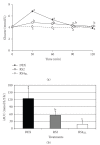Different types of resistant starch elicit different glucose reponses in humans
- PMID: 20700404
- PMCID: PMC2911581
- DOI: 10.1155/2010/230501
Different types of resistant starch elicit different glucose reponses in humans
Abstract
The purpose of this study was to determine whether different types of resistant starch (RS) elicited different glycemic responses. Eleven healthy subjects consumed solutions containing 30 g of either dextrose (DEX), resistant starch type 2 (RS2), or cross-linked resistant wheat starch type 4 (RS4(XL)) on three separate occasions, which were assigned randomly. Finger stick blood samples were collected before and over the following two hours and measured for glucose. The incremental area under the curve (iAUC) for the glucose response was calculated for all trials. The two types of resistant starch significantly (P < .05) decreased iAUC compared with DEX. The response with RS4(XL) was significantly decreased compared with the RS2 trial. These data demonstrate that different types of resistant starch elicit significantly different glycemic responses.
Figures

Similar articles
-
Glycemic and Insulinemic Responses of Healthy Humans to a Nutrition Bar with or without Added Fibersym® RW, a Cross-Linked Phosphorylated RS4-Type Resistant Wheat Starch.Int J Environ Res Public Health. 2022 Oct 24;19(21):13804. doi: 10.3390/ijerph192113804. Int J Environ Res Public Health. 2022. PMID: 36360681 Free PMC article.
-
Consumption of Cross-Linked Resistant Starch (RS4(XL)) on Glucose and Insulin Responses in Humans.J Nutr Metab. 2010;2010:651063. doi: 10.1155/2010/651063. Epub 2009 Aug 23. J Nutr Metab. 2010. PMID: 20798767 Free PMC article.
-
Metabolic Responses to Native Wheat Starch (MidsolTM 50) versus Resistant Wheat Starch Type 4 (Fibersym® RW): Standard versus Marketplace Testing Protocols.Curr Dev Nutr. 2021 Feb 19;5(3):nzab011. doi: 10.1093/cdn/nzab011. eCollection 2021 Mar. Curr Dev Nutr. 2021. PMID: 33758791 Free PMC article.
-
Metabolic Effects of Resistant Starch Type 2: A Systematic Literature Review and Meta-Analysis of Randomized Controlled Trials.Nutrients. 2019 Aug 8;11(8):1833. doi: 10.3390/nu11081833. Nutrients. 2019. PMID: 31398841 Free PMC article.
-
Resistant starch-An accessible fiber ingredient acceptable to the Western palate.Compr Rev Food Sci Food Saf. 2022 May;21(3):2930-2955. doi: 10.1111/1541-4337.12955. Epub 2022 Apr 27. Compr Rev Food Sci Food Saf. 2022. PMID: 35478262 Review.
Cited by
-
Glycemic and Insulinemic Responses of Healthy Humans to a Nutrition Bar with or without Added Fibersym® RW, a Cross-Linked Phosphorylated RS4-Type Resistant Wheat Starch.Int J Environ Res Public Health. 2022 Oct 24;19(21):13804. doi: 10.3390/ijerph192113804. Int J Environ Res Public Health. 2022. PMID: 36360681 Free PMC article.
-
Food Ingredients That Inhibit Cholesterol Absorption.Prev Nutr Food Sci. 2017 Jun;22(2):67-80. doi: 10.3746/pnf.2017.22.2.67. Epub 2017 Jun 30. Prev Nutr Food Sci. 2017. PMID: 28702423 Free PMC article. Review.
-
Harnessing Prebiotics to Improve Type 2 Diabetes Outcomes.Nutrients. 2024 Oct 11;16(20):3447. doi: 10.3390/nu16203447. Nutrients. 2024. PMID: 39458444 Free PMC article. Review.
-
Novel resistant potato starches on glycemia and satiety in humans.J Nutr Metab. 2012;2012:478043. doi: 10.1155/2012/478043. Epub 2012 May 13. J Nutr Metab. 2012. PMID: 22655177 Free PMC article.
-
A High Fiber Cookie Made with Resistant Starch Type 4 Reduces Post-Prandial Glucose and Insulin Responses in Healthy Adults.Nutrients. 2017 Mar 5;9(3):237. doi: 10.3390/nu9030237. Nutrients. 2017. PMID: 28273870 Free PMC article. Clinical Trial.
References
-
- Brown IL, McNaught KJ, Andrews D, Morita T. Resistant Starch: plant breeding, applications, development and commercial uses. In: McCleary BV, Prosky L, editors. Advanced Dietary Fibre Technology. Ames, Iowa, USA: Iowa State University Press, Blackwell Science; 2001.
-
- Englyst KN, Liu S, Englyst HN. Nutritional characterization and measurement of dietary carbohydrates. European Journal of Clinical Nutrition. 2007;61(supplement 1):S19–S39. - PubMed
-
- Jenkins DJA, Kendall CWC. Resistant starches. Current Opinion in Gastroenterology. 2000;16(2):178–183. - PubMed
-
- Nugent AP. Health properties of resistant starch. Nutrition Bulletin. 2005;30(1):27–54.
LinkOut - more resources
Full Text Sources

